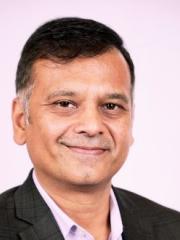Optimizing Workflows in Remote Patient Care
Increasingly, care delivery models seek to optimize the balance of in-hospital and out-of-hospital care. Shifting a greater proportion of the care journey out-of-hospital is intended to manage stresses placed on the health care system caused by increased patient complexity, the rising cost of care, and staffing shortages. In this conversation, we specifically consider advances in remote cardiac patient management. We discuss how integrating the increasing volume of ambulatory ECG data into existing optimized workflows and information systems can reduce emergency room burden and hospital bed usage.
Show Notes
Transcript
Speakers
Increasingly, care delivery models seek to optimize the balance of in-hospital and out-of-hospital care. Shifting a greater proportion of the care journey out-of-hospital is intended to manage stresses placed on the health care system caused by increased patient complexity, the rising cost of care, and staffing shortages. In this conversation, we specifically consider advances in remote cardiac patient management. We discuss how integrating the increasing volume of ambulatory ECG data into existing optimized workflows and information systems can reduce emergency room burden and hospital bed usage.
Matt Smith: Good afternoon, everybody and welcome to our podcast series on digital solutions that ease the way for care teams. I'm Matt Smith with the GE HealthCare marketing team. Today I'm joined by Ashutosh Banerjee and Doctor Ben Green. Ashutosh is the leader of the Digital Cardiology business within GE HealthCare and Doctor Green is senior vice president of clinical services with AliveCor. Ashutosh and Doctor Green are joining us today to discuss optimizing workflows in remote patient care, specifically focusing on best practices in ambulatory ECG workflows. Welcome gentlemen.
Ashutosh Banerjee: Thank you Matt.
Matt Smith: Great to have you. Let's start a little bit with the partnership basics. So, within the last year, I remember, it was at HIMSS 22, we really announced the partnership between GE and AliveCor. Our 2 organizations really came together to provide an immediate benefit both to provider side customers as well as patients. So Ashutosh, if you could talk us through the gap that you identified and how this partnership helps us both fill that gap.
Ashutosh Banerjee: Absolutely Matt thank you for the question. I would say when we looked at our solutions in the hospital space, we have a strong solution with MUSE, our ECG management system. So, our ECG management system allows the hospital users clinicians to take the ECGs and route them within the hospital and work with them, look at the prior history of the patient and prescribe the right decision pathway for them. But the problem that we saw is that when the patient leaves the hospital, they leave care. Because of the hospital is not able to track them outside the hospital and the ECG 's from outside the hospital, whatever happens outside is a black hole.
So, we were on the lookout for a partner who can help us extend our care continuum for each ECG outside the hospital. So that the patient can leave the hospital, but not leave care. So, we worked with a AliveCor. We have been talking to them for maybe over 5 years or 6 years and they are one of the most peer reviewed, highly clinically, accurate, 510 K cleared devices that consumers have been using for a while, outside the hospital in their home settings. And we found that's the perfect device that can help us bridge that gap between what we can see in the hospital and what we can see for patients who have left the hospital and for sending the data back into the hospital.
And maybe Doctor Green, you can talk a little bit more about why you wanted to partner with a company like us and what was the thought behind that.
Dr. Ben Green: Absolutely. Thanks, Ashu. Thanks Matt as well. Ashutosh mentioned care is moving to the home. And patients are in hospitals and when they go home, what happens to them? And for years, AliveCor, with our KardioMobile 6-lead device, and I have one right here, has been used by patients and consumers for many years, for many clinical scenarios. People with atrial fibrillation, people with other diagnosis and other arrhythmias, and fortunately in a lot of cases they're able to share that data with their doctor. However, that has been a challenge. As we know, data is coming in, and there haven't been great ways to share that data directly with their healthcare providers. We have patients and consumers today, that share PDF, they e-mail their doctor, they bring their phone in with the readings from this device. And the doctors, they appreciate it, they love it, they use it, but it's not part of their workflow.
So, with this partnership, it's really exciting to us, to really enable patients and their doctors to really connect the care and connect to each other and to provide a a better experience. So we're really fortunate to be a part of this relationship and there's really a whole lot we could do with it.
Matt Smith: I think that the simplification of clinical workflows, obviously sounds like a clear benefit to clinicians. Ashutosh, since we're at HIMSS, can you talk a little bit about the impact this will have on the IT teams responsible for ensuring ECG data can make its way into these workflows?
Ashutosh Banerjee: Absolutely. One of the top problem areas for IT teams today is how to secure the data that comes in, how to keep the patient data secure, how to protect the devices and their workflows from cyber-attacks and other vulnerabilities. So, the MUSE is already a trusted app in 85% of the hospitals in the US. So, when you use MUSE to bring in additional features and additional devices and additional ECGs from other devices into the hospital, the CIO 's do not have to worry about whether you are opening up another point of vulnerability. So, it actually improves and helps with prevention of cyber-attacks on the hospital systems, that is one. Second, there is a lot of benefit of using a workflow, which the hospital users already know how to use. You don't need to train them all over again, you don't need to keep on retraining the staff and worrying about whether they would understand how to use this, you don't have to worry about 2 different dashboards to use.
And like Doctor Green was saying early, patients were bringing in data on e-mail, they were emailing their physicians, and then you worry about whether you download that import, and where does it go and so. Instead of complicating the workflow, you can simplify the workflow by using an existing application to bring in new features. The 3rd thing I would say is that you are enhancing the value of an app that already exists. So, it in fact, it makes the job of the CIO easier, because the clinical staff is not going to push back or say that we do not like this, or you don't bring us more things that that you're bringing in. They know how to use the product, you are enhancing the features to it, you're getting more information out to the clinicians when they need it. So, I think all that really helps in the workflow, simplifies it, and integrates it for everybody concerned.
Matt Smith: Dr. Green, anything to add?
Dr. Ben Green: Yeah, just to piggyback on the training element for the clinical staff, for the doctors, for the nurses, they don't want to train on yet another platform, another software platform, they have to vet they have to spend a half day training. They don't want to do that, and I think again with this integration, it's a familiar common platform they're already trained on, so it makes it easy to implement.
Matt Smith: You both talked a few times now about the benefit of leveraging the established MUSE workflows to manage and assess cardio mobile data. Doctor Green, can you talk a little bit more specifically about the value of the MUSE workflows specifically to healthcare professionals?
Dr. Ben Green: Yeah, I think we've already touched on it, but I think the main point here is that data is coming, data is here, we're at HIMSS. Obviously, there's a ton of data being generated by consumers Today, by this device, by other devices and that healthcare providers, and clinical staff are being inundated with data. So, this relationship and this integration just makes it easy, it makes it familiar for the doctors and makes it manageable, it makes it actionable versus a PDF or a notebook. When I was practicing in the clinic, patients would come in with reams of paper and I would have to shift through that data to make an actual decision. That goes away now, with this MUSE integration, so I think that's really the great value here.
Matt Smith: Ashutosh, any insights?
Ashutosh Banerjee: I would just say that MUSE is the standard workflow for ECGs in a hospital. MUSE usually runs the heart station in a hospital, where the cardiologist would overwrite the ECG and decide whether it's the right one, or whether we need to redo it, or what's the treatment plan for the patient. The more value we can add on to MUSE by bringing in ECGs from various points of care, the more value to the MUSE workflow, and I think our aim is to ensure that we can provide clinicians with the right information, at the right time, so that the patient care is really taken care of. So, I think it's the right workflow. our customers are telling us the same thing, we are hearing that this is definitely something that they are looking to in terms of the both the enhancement, and it makes care better for patients.
Matt Smith: Terrific. Doctor Green, can you speak a little bit to the scenarios that are ideal candidates for the cardio mobile MUSE configuration? maybe a little bit about each of these in detail and what are some of the benefits to the health system?
Dr. Ben Green: Sure, first off, there are numerous examples and clinical use cases where the KardioMobile 6L really, really comes into play. I'll speak about what we've seen and where consumers are using the device at home to manage conditions. The first is atrial fibrillation, which is the most common heart arrhythmia it affects 1-2% of the adult population, and it's a condition that it is difficult to manage, and it causes a lot of anxiety with patients. So, patients who have the KardioMobile 6L device, now are able to check themselves when they have symptoms, when they have anxiety, when they have concerns and they're able to see whether or not they're in atrial fibrillation or not, and then importantly, share that data back to their care provider. Now with MUSE, that data seamlessly goes back to the provider to allow them to make an actual decision. What that leads to is reductions in ER visits, reductions in hospitalizations, unnecessary ER visits and hospitalizations and we've seen that. We've had some clinical studies showing that the KardioMobile device does, in fact, reduce our usage and hospitalizations, just simply due to the fact that doctor now has the ability to intervene virtually with that patient in that home setting.
The other use case that I think is an increasingly important one is QT prolongation. QT prolongation is an issue that can lead to fatal arrhythmias and there are many medications now and increasingly that are causing QT prolongation. There are antiarrhythmic medications, which are used to treat atrial fibrillation, but there are a host of other medications, including oncology medications, psychiatric medications, that cause a prolongation of the QT. So what happens and what is needed is frequent measurement of that interval and traditionally that requires an EKG, so that patient has to drive in, come in, get an EKG, the doctor says looks great, go home and we can adjust your medication, or come on in, oops, it's actually looking longer, I need to adjust the medication, but again, it takes time, it takes resources, it takes a lot of effort on the patients end to do that. Now that QT measurement can be done purely remotely, and that QT measurement can flow through MUSE, the Doctor can quickly see, the interval looks good, or the interval is starting to prolong and need to adjust the medication, and now we've created a new workflow and a much better patient experience. So, I think those are really two great use cases where we're seeing this in action and with this integration it just becomes a no brainer.
Matt Smith: Anything to add?
Ashutosh Banerjee: I'll just say that another one that's coming up and maybe you can confirm that is the titration for atrial fibrillation medicines at home. So today, the patients need to come into the hospital, and the clinic and I see whether the medicine is working and then adjust it. With this you can take the reading at home and send it in through MUSE and based on that, the physician can just help titrate the medicine dose while the patients at home. Saves cost and saves time for the already overloaded urgent care and maybe their position practices.
Dr. Ben Green: Exactly, and just to piggyback on that, so typically that loading that you're talking about sotalol loading and for example, requires a 3-day hospital stay. And that requirement is essentially to monitor the QT, so now we can move that to the home setting, you've eliminated a 3-day hospitalization, which obviously is costly, but also introduces a lot of potential complications for that patient. That now goes away and it's really a simple thing, but we're now able to do that with this relationship.
Matt Smith: So, I think that we've talked a little bit more about the benefits to the care teams, you've touched on some of the benefits to the patients. We can go a little bit deeper, maybe into the patient benefits. What do you see here some extra benefits that you haven't mentioned yet?
Dr. Ben Green: Yeah, I think at its core, what this can provide with this connection is peace of mind and reassurance for these patients. Atrial fibrillation, when someone is first diagnosed with that condition, it is life changing for them. It is terribly anxiety provoking and, in many cases, it limits people´s normal day-to-day lives. With this device, with the ability for the doctors to see the data in real time, people feel liberated that they're able to now live their lives with peace of mind. They know someone 's looking at this data, they know if they're having symptoms, they can alert someone. We have patients that tell us that, that you've changed my life with this. And the other thing, though I'll say is early intervention. So, there are absolutely times and cases where that person should go to the hospital, they should go to the ER and with this data, and with the connection to the doctor they're not able to be notified in the right time, at the right moment. And I think it's critically important that the right people are going to the hospital at the right time, not when it's not too late. Importantly, like I said, before also keeping people that don't need to be there, at home with that peace of mind.
Ashutosh Banerjee: Yeah, and maybe just to piggyback on that I would say that if I add a few data points for arrhythmia and Afib patients. It has been seen that 30% of the visits to the ED are actually not required. So, they are usually frequent Flyers and 30% of the visits to the ED are not required. See, if you can have this track like Doctor Green said, then we can prevent those and again that's cost saving to the hospital. To the patient not only confidence, but the fact that I know that my doctor, my physician, has access to my records when there is something that can go wrong is very import. There are so many cases where lives are saved because you had AliveCor at home, and there are documented cases with you, right, at AliveCor, where patients have come in and said if I did not have this, I caught my disease, while I was on an aircraft or was while I was at home while I was shoveling snow, stuff like that. And so, health outcomes is such an important thing for us. People at home can be assured that because they are connected with their doctors, their condition will be caught, and they'll get the right treatment and support when they need it.
Matt Smith: Terrific. I am going to wrap it up, so thanks for talking with us today. This has really helped us better understand the value created, not only do we have a trusted ambulatory ECG solution, but a more complete ecosystem. One last question, is there anything else that you want to leave the audience with?
Dr. Ben Green: Go ahead.
Ashutosh Banerjee: I would just say that our goal in GE HealthCare is to ensure that we can complete the care continuum for our customers, for our clinicians. We want to make sure that we are providing the right information at the right time without overloading the physician. So, we are not here to just throw data at the physicians and say make sense of it, we are here to provide information, which is controlled by the physician. So here the physician controls who gets the device on a prescription. The order is placed through MUSE, and they can control who gets the device and they control which data, which ECG they want to read and at what frequency they want to read it. It's not that anyone can send in the ECG, and we don't want to create more data than is necessary. So, it's all about creating an ecosystem of offerings, of solutions that create those insights that allow better patient care. And on the other hand, because we are focused on the patients, we are allowing the patients to be confident about their care, and also feel confident that their doctor is going to be looking out for them because they are connected, right? So that's important for us. Whatever we bring in, we will keep in mind the care continuum and we'll keep in mind that we do so without overloading the physician.
Matt Smith: Last word?
Dr. Ben Green: I think we talked a lot about the quadruple aim in healthcare and I think it's probably overused, and I think a lot of times, there's a lot of lip service to that term. But I truly think this relationship and this integration really checks all those boxes and it improves health care outcomes, it improves the patient experience of care, it does, in fact, reduce costs and improves the provider experience of care. And it's hard to argue with any of those elements in what we're doing here, but ultimately this is about patients, this is about people 's lives and this is truly going to transform how people with these devastating conditions can live healthier and more reassuring lives.
Matt Smith: Terrific. Thank you both for joining us today. Dr. Ben Green and Ashutosh Banerjee, everybody.

Matt Smith
Over 25 years of professional marketing, communications, and business development experience in the healthcare industry.
At GE HealthCare, he leads the global marketing function for the growth strategy of the Clinical Software portfolios--including Mural Virtual Care Solution, Mural Connect, and Centricity High Acuity software. Key areas of expertise include: product development; business development; content development; branding and identity; public relations; demand generation; digital outreach, and video production.

Ben Green, MD
Senior Vice President of Clinical Services, AliveCor
Dr. Ben Green has nearly 15 years of experience in telemedicine. As SVP of Services at AliveCor, Dr. Green oversees all care delivery and clinical operations. He continuously explores new ways to deliver high-quality, clinically meaningful, and customer-centric experiences for AliveCor users.
Prior to joining AliveCor, Dr. Green spent several years at Amazon as the founding Chief Medical Officer for Amazon’s first pursuit into virtual care delivery, Amazon Care, and later as the Principal of Healthcare Innovation for Amazon Global Benefits. Dr. Green has also served as Regional Medical Director at Landmark Health, an at-risk housecall model, and spent eight years at Carena, Inc., an early telemedicine company offering virtual services for health systems and employers. Dr. Green holds a BA from Harvard University, an MD degree from UMDNJ-Robert Wood Johnson Medical school, and completed his family medicine residency at the University of Pennsylvania.

Ashutosh Banerjee
General Manager, Cardiology Solutions & Remote Patient Monitoring, GE HealthCare
Business turn-around and growth specialist. Over a career spanning two decades he has led teams in sales, operations, marketing and now in product management and have experience across several industries ranging from consumer durable, IT to healthcare with both India/South Asia and global geographical experience for multinational corporations. He has successfully turned around and grown struggling businesses, as well as starting up new businesses and new revenue streams - be it the largest region for Johnson & Johnson's diabetes business in India, or a new greenfield unit for Asian Paints in a new geography, or his current role in GE HealthCare. Ashutosh Banerjee is known for his strategic, operational and people skills and he is a decisive leader with a vision that his team likes to follow and execute on.
At GE HealthCare there are solutions that help clinicians help triage, diagnose and treat patients with CVD worldwide. Ashutosh is currently in charge of harmonizing and integrating the cardiology offerings across GE HealthCare. He is also the Global Business Head (GM) for the Diagnostic Cardiology business. This business is hyperfocused on the ECG ecosystem and they continuously listen to our customers and patients to design, manufacture and sell products (resting, stress ECG systems, ECG management and Ambulatory ECG devices and systems), intelligence and solutions that help clinicians triage and diagnose CVD to save lives worldwide everyday.












